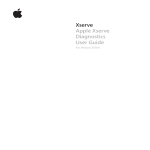Download Dell 1470 Laptop User Manual
Transcript
INSPIRON ™ SETUP GUIDE INSPIRON ™ SETUP GUIDE Models P04F and P04G series Types P04F001 and P04G001 Notes, Cautions, and Warnings NOTE: A NOTE indicates important information that helps you make better use of your computer. CAUTION: A CAUTION indicates either potential damage to hardware or loss of data and tells you how to avoid the problem. WARNING: A WARNING indicates a potential for property damage, personal injury, or death. __________________ Information in this document is subject to change without notice. © 2009 Dell Inc. All rights reserved. Reproduction of these materials in any manner whatsoever without the written permission of Dell Inc. is strictly forbidden. Trademarks used in this text: Dell, the DELL logo, Inspiron, YOURS IS HERE, and DellConnect are trademarks of Dell Inc.; Intel, Pentium, and Celeron are registered trademarks and Core is a trademark of Intel Corporation in the U.S. and other countries; Microsoft, Windows, Windows Vista, and Windows Vista start button logo are either trademarks or registered trademarks of Microsoft Corporation in the United States and/or other countries; Blu-ray Disc is a trademark of the Blu-ray Disc Association; Bluetooth is a registered trademark owned by Bluetooth SIG, Inc. and is used by Dell under license. Other trademarks and trade names may be used in this document to refer to either the entities claiming the marks and names or their products. Dell Inc. disclaims any proprietary interest in trademarks and trade names other than its own. July 2009 P/N 81TR2 Rev. A00 Contents Setting Up Your Inspiron Laptop������������������5 Display Features�������������������������������������������� 28 Before Setting Up Your Computer ���������������� 5 Dell Extended Battery Life���������������������������� 30 Connect the AC Adapter �������������������������������� 6 Removing and Replacing the Battery���������� 30 Connect the Network Cable (Optional)���������� 7 Software Features ���������������������������������������� 32 Press the Power Button���������������������������������� 8 Dell Dock�������������������������������������������������������� 35 Set Up Microsoft Windows���������������������������� 9 Solving Problems ����������������������������������������36 Enable or Disable Wireless (Optional)�������� 10 Beep or LED Codes���������������������������������������� 36 Connect to the Internet (Optional) �������������� 12 Network Problems ���������������������������������������� 37 Using Your Inspiron Laptop ������������������������16 Power Problems�������������������������������������������� 38 Right View Features�������������������������������������� 16 Memory Problems������������������������������������������ 39 Left View Features ���������������������������������������� 18 Lockups and Software Problems ���������������� 40 Front View Features�������������������������������������� 20 Using Support Tools ������������������������������������42 Computer Base and Keyboard Features���������������������������������������������������������� 22 Dell Support Center �������������������������������������� 42 Touch Pad Gestures�������������������������������������� 24 Multimedia Control Keys ������������������������������ 26 System Messages������������������������������������������ 43 Hardware Troubleshooter ���������������������������� 45 Dell Diagnostics �������������������������������������������� 45 3 Contents Restoring Your Operating System ������������50 System Restore���������������������������������������������� 50 Finding More Information and Resources ����������������������������������������������������64 Dell Factory Image Restore�������������������������� 52 Basic Specifications ����������������������������������66 Operating System Reinstallation������������������ 54 Appendix ������������������������������������������������������72 Getting Help��������������������������������������������������56 Macrovision Product Notice������������������������ 72 Technical Support and Customer Service������������������������������������������������������������ 57 Information for NOM, or Official Mexican Standard (only for Mexico) ���������� 73 DellConnect���������������������������������������������������� 57 Index��������������������������������������������������������������74 Online Services���������������������������������������������� 58 Automated Order-Status Service ���������������� 59 Product Information�������������������������������������� 59 Returning Items for Repair Under Warranty or for Credit ���������������������������������� 60 Before You Call���������������������������������������������� 61 Contacting Dell���������������������������������������������� 63 4 This section provides information about setting up your Dell™ Inspiron™ 1470/1570 laptop. Before Setting Up Your Computer When positioning your computer, ensure that you allow easy access to a power source, adequate ventilation, and a level surface to place your computer. Restricting airflow around your Inspiron laptop may cause it to overheat. To prevent overheating ensure that you leave at least 10.2 cm (4 inches) at the back of the computer and a minimum of 5.1 cm (2 inches) on all other sides. You should never place your computer in an enclosed space, such as a cabinet or drawer when it is powered on. WARNING: Do not block, push objects into, or allow dust to accumulate in the air vents. Do not place your Dell computer in a low-airflow environment, such as a closed briefcase, while it is powered on. Restricting the airflow can damage the computer or cause a fire. The computer turns on the fan when the computer gets hot. Fan noise is normal and does not indicate a problem with the fan or the computer. CAUTION: Placing or stacking heavy or sharp objects on the computer may result in permanent damage to the computer. 5 INSPIRON Setting Up Your Inspiron Laptop Setting Up Your Inspiron Laptop Connect the AC Adapter Connect the AC adapter to the computer and then plug it into a wall outlet or surge protector. WARNING: The AC adapter works with electrical outlets worldwide. However, power connectors and power strips vary among countries. Using an incompatible cable or improperly connecting the cable to a power strip or electrical outlet may cause fire or permanent damage to your computer. NOTE: Connect the power cord to the adapter firmly and ensure that the light on the adapter is on when you turn on power. NOTE: Use only Dell AC adapter family PA-3E, PA-10, and PA-12 with your computer. 6 Setting Up Your Inspiron Laptop Connect the Network Cable (Optional) To use a wired network connection, connect the network cable. 7 Setting Up Your Inspiron Laptop Press the Power Button 8 Setting Up Your Inspiron Laptop Set Up Microsoft Windows Your Dell computer is preconfigured with Microsoft® Windows® operating system. To set up Windows for the first time, follow the instructions on the screen. These steps are mandatory and may take some time to complete. The Windows setup screens will take you through several procedures including accepting license agreements, setting preferences, and setting up an Internet connection. CAUTION: Do not interrupt the operating system’s setup process. Doing so may render your computer unusable and you will need to reinstall the operating system. NOTE: For optimal performance of your computer, it is recommended that you download and install the latest BIOS and drivers for your computer available on the Dell Support website at support.dell.com. 9 Setting Up Your Inspiron Laptop Enable or Disable Wireless (Optional) Press the key or press the <Fn><F2> keys on the keyboard to enable or disable wireless. The wireless on or off icons appear on the screen to indicate the status. Wireless on: Wireless off: For information on changing the behavior of the Fn key, see “Multimedia Control Keys” on page 26. 10 Setting Up Your Inspiron Laptop 11 Setting Up Your Inspiron Laptop Connect to the Internet (Optional) To connect to the Internet, you need an external modem or network connection and an Internet Service Provider (ISP). If an external USB modem or WLAN adapter is not a part of your original order, you can purchase one from the Dell website at www.dell.com. 12 Setting Up a Wired Connection •If you are using a DSL or cable/satellite modem connection, contact your ISP or cellular telephone service for setup instructions. •If you are using a dial-up connection, connect the telephone line to the optional external USB modem and to the telephone wall connector before you set up your Internet connection. To complete setting up your wired Internet connection, follow the instructions in “Setting Up Your Internet Connection” on page 14. Setting Up Your Inspiron Laptop Setting Up a Wireless Connection NOTE: To set up your wireless router, see the documentation that shipped with your router. Before you can use your wireless Internet connection, you need to connect to your wireless router. To setup your connection to a wireless router: Windows Vista® 1. Ensure that wireless is enabled on your computer (see “Enable or Disable Wireless” on page 10). Windows® 7 1. Ensure that wireless is enabled on your computer (see “Enable or Disable Wireless” on page 10). 2. Save and close any open files, and exit any open programs. 3. Click Start → Control Panel→ Network and Sharing Center→ Connect to a network. 4. Follow the instructions on the screen to complete the setup. 2. Save and close any open files, and exit any open programs. 3. Click Start → Connect To. 4. Follow the instructions on the screen to complete the setup. 13 Setting Up Your Inspiron Laptop Setting Up Your Internet Connection To set up your Internet connection: ISPs and ISP offerings vary by country. Contact your ISP for offerings available in your country. Windows Vista® If you cannot connect to the Internet but have successfully connected in the past, the Internet Service Provider (ISP) might have a service outage. Contact your ISP to check the service status, or try connecting again later. Have your ISP information ready. If you do not have an ISP, the Connect to the Internet wizard can help you get one. NOTE: The following instructions are applicable to the Windows default view, so they may not apply if you set your Dell™ computer to the Windows Classic view. 1. Save and close any open files, and exit any open programs. 2. Click Start → Control Panel. 3. Click Network and Internet→ Network and Sharing Center→ Set up a connection or Network→ Connect to the Internet. The Connect to the Internet window appears. NOTE: If you do not know which type of connection to select, click Help me choose or contact your ISP. 4. Follow the instructions on the screen and use the setup information provided by your ISP to complete the setup. 14 Setting Up Your Inspiron Laptop Windows® 7 1. Save and close any open files, and exit any open programs. 2. Click Start → Control Panel→ Network and Sharing Center→ Set up a new connection or network→ Connect to the Internet. The Connect to the Internet window appears. NOTE: If you do not know which type of connection to select, click Help me choose or contact your ISP. 3. Follow the instructions on the screen and use the setup information provided by your ISP to complete the setup. 15 INSPIRON Using Your Inspiron Laptop This section provides information about the features available on your Inspiron 1470/1570 laptop. Right View Features 1 16 2 3 4 Using Your Inspiron Laptop 1 USB 2.0 connectors (2) – Connects to USB devices, such as a mouse, keyboard, printer, external drive, or MP3 player. 2 Optical drive – Plays or records CDs, DVDs, or Blu-ray Discs (optional). Ensure that the side with print or writing is facing upward when inserting discs. CAUTION: This drive supports nonstandard-sized and -shaped discs; however, degradation in drive performance may be experienced, and in extreme cases, the drive may be damaged. 3 Eject button – Opens the optical drive tray when pressed. 4 AC adapter connector – Connects to the AC adapter to power the computer and charge the battery. 17 Using Your Inspiron Laptop Left View Features 1 18 2 3 4 5 6 Using Your Inspiron Laptop 1 Security cable slot – Attaches a commercially available antitheft device to the computer. NOTE: Before you buy an antitheft device, ensure that it works with the security cable slot on your computer. 2 3 VGA connector – Connects to video devices, such as a monitor or a projector. HDMI connector – Connects to a TV for both 5.1 audio and video signals. NOTE: When used with a monitor, only the video signal is read. 4 Network connector – Connects your computer to a network or a broadband device if you are using a wired network. 5 USB 2.0 connector – Connects to USB devices, such as a mouse, keyboard, printer, external drive, or MP3 player. 6 SD/MMC - MS/Pro 7-in-1 Memory Card Reader – Provides a fast and convenient way to view and share digital photos, music, videos, and documents stored on the memory cards (see “Basic Specifications” on page 66 for supported memory cards). NOTE: Your computer ships with a plastic blank installed in the memory card slot. Blanks protect unused slots from dust and other particles. Save the blank for use when no memory card is installed in the slot; blanks from other computers may not fit your computer. 19 Using Your Inspiron Laptop Front View Features 1 2 20 Using Your Inspiron Laptop 1 Audio in/Microphone connector – Connects to a microphone or inputs signal for use with audio programs. 2 Audio out/Headphone connector – Connects to headphones or sends audio to a powered speaker or sound system. 21 Using Your Inspiron Laptop Computer Base and Keyboard Features 1 22 2 3 4 5 Using Your Inspiron Laptop 1 Power/Battery activity indicator – Indicates the following power/battery charge states: •Solid white – Computer is on, and the AC adapter is charging the battery. •Solid amber – Computer is in stand-by mode, and the battery charge is low. •Blinking white – Computer in stand-by mode, and the AC adapter is charging the battery or the battery charge is good. •Off – Computer is off or in hibernate state. 2 Power button – Turns the computer on or off when pressed. 3 Keyboard/Multimedia control keys – For more information about the keyboard, see the Dell Technology Guide. For more information about the multimedia control keys, see “Multimedia Control Keys” and page 26. 4 Touch pad buttons – Provide left-click and right-click functions like those on a mouse. 5 Touch pad – Provides the functionality of a mouse to move the cursor, drag or move selected items, and right-click or left-click by tapping the surface. The touch pad supports the Scroll, Flick, Zoom, Rotate, and Desktop features. To change the touch pad settings, double-click the Dell Touch pad icon in the notification area of the desktop. 23 Using Your Inspiron Laptop Touch Pad Gestures Scroll Allows you to scroll through content. The scroll feature includes: Pan – Allows you to move the focus on the selected object when the entire object is not visible. Move two fingers in the desired direction to pan scroll the selected object. Auto Scroll Vertical – Allows you to scroll up or down on the active window. Move two fingers up or down at a fast pace to activate vertical auto scrolling. Tap on the touch pad to stop auto scrolling. 24 Auto Scroll Horizontal – Allows you to scroll left or right on the active window. Move two fingers to your left or right at a fast pace to activate horizontal auto scrolling. Tap on the touch pad to stop auto scrolling. Flick Allows you to flip content forward or backward based on the direction of the flick. Move three fingers quickly in the desired direction to flip content in the active window. Using Your Inspiron Laptop Zoom Rotate Allows you to increase or decrease the magnification of the screen content. The zoom feature includes: Allows you to rotate the active content on the screen. The rotate feature includes: Pinch – Allows you to zoom in or zoom out by moving two fingers apart or bringing them closer together on the touch pad. To zoom in: Move two fingers apart to enlarge the view of the active window. To zoom out : Move two fingers close together to reduce the view of the active window. Twist – Allows you to rotate active content in 90° increments using two fingers where one finger is anchored and the other rotates. Keeping the thumb in place, move the index finger in an arced direction right or left to rotate the selected item 90° clockwise or counterclockwise. Desktop Allows you to minimize all open windows so that the desktop is visible. Place your hand on the touch pad in any orientation, briefly hold in place and then remove your hand. 25 Using Your Inspiron Laptop Multimedia Control Keys You can configure the multimedia control keys on the keyboard using the Function Key Behavior in the System Setup (BIOS) utility. The options in the Function Key Behavior setting are: Multimedia Key First – This is the default setting. Pressing any multimedia control key performs the associated multimedia action. For function key, press <Fn> + the required function key. Function Key First – Pressing any function key performs the associated function. For multimedia action, press <Fn> + the required multimedia control key. NOTE: The Multimedia Key First option is active only in the operating system. 26 Using Your Inspiron Laptop Mute the sound Play or pause Decrease the volume level Play the next track or chapter Increase the volume level Eject the disc Play the previous track or chapter 27 Using Your Inspiron Laptop Display Features The display panel holds a camera and accompanying digital microphone. 1 28 2 3 4 Using Your Inspiron Laptop 1 Digital microphone – Provides quality sound for audio chatting and voice recording. 2 Camera activity indicator – Indicates if the camera is on or off. 3 Camera – Built-in camera for video capture, conferencing, and chat. 4 Display – Your display can vary based on selections you made when purchasing your computer. For more information about displays, see the Dell Technology Guide. 29 Using Your Inspiron Laptop Dell Extended Battery Life The Dell Extended Battery Life feature provides options to derive the maximum backup time from your battery. This feature is enabled by default and is activated when you disconnect the AC power. Press <F3> to enable or disable the feature. The Extended Battery Life pop-up appears to indicate the current status. To learn more about the customization options for Dell Extended Battery Life: 1. Press <F3>. The Extended Battery Life pop-up appears. 2. Click Show Settings. The Battery Meter window appears. 3. Click What is Dell Extended Battery Life? Removing and Replacing the Battery WARNING: Using an incompatible battery may increase the risk of fire or explosion. This computer should only use a battery purchased from Dell. Do not use batteries from other computers. WARNING: Before removing the battery, shut down the computer, and remove external cables (including the AC adapter). To remove the battery: 1. Shut down the computer and turn it over. 2. Slide the battery release latch to the side. 3. Slide the battery away from the battery bay. To replace the battery: 1. Slide the battery into the battery bay. 2. Click the battery into place. 30 Using Your Inspiron Laptop 1 2 3 1 2 3 battery battery bay battery release latch 31 Using Your Inspiron Laptop Software Features NOTE: For more information about the features described in this section, see the Dell Technology Guide on your hard drive or on the Dell Support website at support.dell.com. Productivity and Communication You can use your computer to create presentations, brochures, greeting cards, fliers, and spreadsheets. You can also edit and view digital photographs and images. Check your purchase order for software installed on your computer. After connecting to the Internet, you can access websites, setup an e-mail account, and upload or download files. Entertainment and Multimedia You can use your computer to watch videos, play games, create your own CDs/DVDs, listen to music or internet radio stations. Your optical disc 32 drive may support multiple disc media formats including CDs, DVDs, and Blu-ray Discs (optional). You can download or copy pictures and video files from portable devices, such as digital cameras and cell phones. Optional software applications enable you to organize and create music and video files that can be recorded to disc, saved on portable products such as MP3 players and handheld entertainment devices, or played and viewed directly on connected TVs, projectors, and home theater equipment. Customizing the Desktop You can use the customizing options available in your operating system to change the appearance, resolution, wallpaper, screensaver, or other features on your desktop. Windows Vista® 1. Right-click an open area of the desktop. 2. Click Personalize, to open the Personalize appearance and sounds window and learn more about your customization options. Using Your Inspiron Laptop Windows® 7 1. Right-click an open area of the desktop. 2. Click Personalize, to open the Change the visuals and sounds on your computer window and learn more about your customization options. Customizing Your Energy Settings You can use the power options in your operating system to configure the power settings on your computer. The Microsoft® Windows® operating system installed on your Dell computer provides three default options: Windows Vista® •High performance — Provides the highest level of system performance on your computer by adapting processor speed to your activity and by maximizing system performance. Windows® 7 •Power saver — Saves power on your computer by reducing system performance to maximize the life of the computer and by reducing the amount of energy consumed by your computer over its lifetime. •Balanced (recommended) — Automatically balances the performance of your computer by consuming energy on capable hardware. •Dell Recommended — Offers full performance when you need it and saves power during periods of inactivity. •Power saver — Saves power on your computer by reducing system performance to maximize the life of the computer and by reducing the amount of energy consumed by your computer over its lifetime. 33 Using Your Inspiron Laptop Transferring Information to a New Computer ® Windows Vista NOTE: The following steps are applicable for the Windows default view, so they may not apply if you set your Dell™ computer to the Windows Classic view. 1. Click Start → Control Panel→ System and Maintenance→ Welcome Center→ Transfer files and settings. If the User Account Control window appears, click Continue. 2. Follow the instructions on the Windows Easy Transfer wizard. Windows® 7 1. Click Start → Control Panel→ Getting Started→ Transfer files from another computer. 2. Follow the instructions on the Windows Easy Transfer wizard. 34 Backing Up Your Data It is recommended that you periodically back up files and folders on your computer. To back up files: Windows Vista® 1. Click Start → Control Panel→ System and Maintenance→ Back Up and Restore Center→ Back up files. If the User Account Control window appears, click Continue. NOTE: Certain editions of Windows Vista provide an option to back up your computer. 2. Follow the instructions on the Back Up Files wizard. Windows® 7 1. Click Start → Control Panel→ Back Up and Restore. 2. Click Set up backup.... 3. Follow the instructions on the Configure Backup wizard. Using Your Inspiron Laptop Dell Dock The Dell Dock is a group of icons that provide easy access to frequently-used applications, files, and folders. You can personalize the Dock by: •Adding or removing icons •Changing the color and location of the Dock •Grouping related icons into categories Add a Category •Changing the behavior of the icons Remove a Category or Icon 1. Right-click the Dock, click Add→ Category. The Add/Edit Category window appears. 1. Right-click the category or icon on the Dock and click Delete shortcut or Delete category. 2. Enter a title for the category in the Title field. 2. Follow the instructions on the screen. 3. Select an icon for the category from the Select an image: box. 4. Click Save. Add an Icon Drag and drop the icon to the Dock or a category. Personalize the Dock 1. Right-click the Dock and click Advanced Setting.... 2. Choose the desired option to personalize the Dock. 35 INSPIRON Solving Problems This section provides troubleshooting information for your computer. If you cannot solve your problem using the following guidelines, see “Using Support Tools” on page 42 or “Contacting Dell” on page 63. WARNING: Only trained service personnel should remove the computer cover. See the Service Manual on the Dell Support website at support.dell.com for advanced service and troubleshooting instructions. 36 Beep or LED Codes If your monitor cannot display errors or problems, your computer may emit a series of beeps or the power/battery activity indicator may flash in various sequences during start-up. If this occurs, Contact Dell (see “Contacting Dell” on page 65) for further assistance. Solving Problems Network Problems Wireless Connections If the wireless network connection is lost — The wireless router is offline or wireless has been disabled on the computer. •Check your wireless router to ensure it is powered on and connected to your data source (cable modem or network hub). Wired Connections If the wired network connection is lost — The cable is loose or damaged. •Check the cable to ensure it is plugged in and not damaged. •If the problem persists, contact your network administrator or ISP. •Interference may be blocking or interrupting your wireless connection. Try moving the computer closer to your wireless router. •Re-establish your connection to the wireless router (see “Setting Up a Wireless Connection” on page 13). 37 Solving Problems Power Problems If the power light is off — The computer is either turned off, in hibernate state, or not receiving power. •Press the power button. The computer resumes normal operation if it is off or in hibernate mode. •Reseat the power cable into both the power connector on the computer and the electrical outlet. •If the computer is plugged into a power strip, ensure that the power strip is plugged into an electrical outlet and that the power strip is turned on. Also bypass power protection devices, power strips, and power extension cables to verify that the computer turns on properly. •Ensure that the electrical outlet is working by testing it with another device, such as a lamp. 38 •Check the AC adapter cable connections. If the AC adapter has a light, ensure that the light on the AC adapter is on. If the power light is solid white and the computer is not responding — The display may not be responding. Press the power button until the computer turns off and then turn it back on. If the power light is blinking white — The computer is in standby mode. Move the mouse, touch the touch pad, or press the power button to resume normal operation. If the power light is solid amber — The computer is in standby mode and the battery charge is low. •Connect the AC adapter to charge the battery. •Move the mouse, touch the touch pad, or press the power button to resume normal operation. Solving Problems If you encounter interference that hinders reception on your computer — An unwanted signal is creating interference by interrupting or blocking other signals. Some possible causes of interference are: • Power, keyboard, and mouse extension cables. • Too many devices connected to a power strip. •Multiple power strips connected to the same electrical outlet. Memory Problems If you receive an insufficient memory message — •Save and close any open files and exit any open programs you are not using to see if that resolves the problem. •See the software documentation for minimum memory requirements. If necessary, install additional memory (see the Service Manual on the Dell Support website at support.dell.com). •Reseat the memory modules (see the Service Manual on the Dell Support website at support.dell.com) to ensure that your computer is successfully communicating with the memory. If you experience other memory problems — •Ensure that you are following the memory installation guidelines (see the Service Manual on the Dell Support website at support.dell.com). • Check if the memory module is compatible with your computer. Your computer supports DDR3 memory. For more information about the type of memory supported by your computer, see “Basic Specifications” on page 66. •Run the Dell Diagnostics (see “Dell Diagnostics” on page 45). • Reseat the memory modules (see the Service Manual on the Dell Support website at support.dell.com) to ensure that your computer is successfully communicating with the memory. 39 Solving Problems Lockups and Software Problems If the computer does not start up — Ensure that the power cable is firmly connected to the computer and to the electrical outlet. If a program stops responding — End the program: 1. Press <Ctrl><Shift><Esc> simultaneously. 2. Click Applications. 3. Click the program that is no longer responding 4. Click End Task. If a program crashes repeatedly — Check the software documentation. If necessary, uninstall and then reinstall the program. NOTE: Software usually includes installation instructions in its documentation or on the CD. 40 If the computer stops responding or a solid blue screen appears — WARNING: You might lose data if you are unable to perform an operating system shutdown. If you are unable to get a response by pressing a key on your keyboard or moving your mouse, press the power button for at least 8 to 10 seconds until the computer turns off and then restart your computer. If a program is designed for an earlier Microsoft® Windows® operating system — Run the Program Compatibility Wizard. The Program Compatibility Wizard configures a program so that it runs in an environment similar to an earlier version of Microsoft Windows operating system environments. Solving Problems To run the Program Compatability Wizard: Windows Vista ® 1. Click Start → Control Panel→ Programs→ Use an older program with this version of Windows. 2. In the welcome screen, click Next. 3. Follow the instructions on the screen. Windows® 7 1. Click Start . 2. In the search box, type Use an older program with this version of Windows and press <Enter>. 3. Follow the instructions on the Program Compatibility wizard. If you have other software problems — •Back up your files immediately. •Use a virus-scanning program to check the hard drive or CDs. •Save and close any open files or programs and shut down your computer through the Start menu. •Check the software documentation or contact the software manufacturer for troubleshooting information: ––Ensure that the program is compatible with the operating system installed on your computer. ––Ensure that your computer meets the minimum hardware requirements needed to run the software. See the software documentation for information. ––Ensure that the program is installed and configured properly. ––Verify that the device drivers do not conflict with the program. ––If necessary, uninstall and then reinstall the program. 41 INSPIRON Using Support Tools Dell Support Center The Dell Support Center helps you find the service, support, and system-specific information you need. To launch the application, click the taskbar. icon in the The Dell Support Center home page displays your computer’s model number, service tag, express service code, and service contact information. The home page also provides links to access: Self Help (Troubleshooting, Security, System Performance, Network/Internet, Backup/ Recovery, and Windows operating system) 42 Alerts (technical support alerts relevant to your computer) Assistance from Dell (Technical Support with DellConnect™, Customer Service, Training and Tutorials, How-To Help with Dell on Call, and Online Scan with PC CheckUp) About Your System (System Documentation, Warranty Information, System Information, Upgrades & Accessories) For more information about Dell Support Center and available support tools, click the Services tab at support.dell.com. Using Support Tools System Messages If your computer has an issue or error, it may display a System Message that will help you identify the cause and action needed to resolve the issue. NOTE: If the message you received is not listed in the following examples, see the documentation for either the operating system or the program that was running when the message appeared. Alternatively you could see the Dell Technology Guide on your hard drive or on the Dell Support website at support.dell.com or see “Contacting Dell” on page 63 for assistance. Alert! Previous attempts at booting this system have failed at checkpoint [nnnn]. For help in resolving this problem, please note this checkpoint and contact Dell Technical Support — The computer failed to complete the boot routine three consecutive times for the same error. Contact Dell for assistance (see “Contacting Dell” on page 63). CMOS checksum error — Possible motherboard failure or Real Time Clock (RTC) battery low. Replace the RTC coin-cell battery (see the Service Manual on the Dell Support website at support.dell.com) or contact Dell (see “Contacting Dell” on page 63). CPU fan failure — CPU fan has failed. Replace the CPU fan (see the Service Manual on the Dell Support website at support.dell.com). Hard-disk drive failure — Possible hard disk drive failure during POST. Contact Dell for assistance (see “Contacting Dell” on page 63). Hard-disk drive read failure — Possible hard disk drive failure during HDD boot test. Contact Dell for assistance (see “Contacting Dell” on page 63). Keyboard failure — Keyboard failure or loose cable. To replace the keyboard, see the Service Manual on the Dell Support website at support.dell.com. 43 Using Support Tools No boot device available — No bootable partition on hard disk drive, the hard disk drive cable is loose, or no bootable device exists. •If the hard drive is your boot device, ensure that the cables are connected and that the drive is installed properly and partitioned as a boot device. •Enter system setup and ensure that the boot sequence information is correct (see the Dell Technology Guide on the Dell Support website at support.dell.com). No timer tick interrupt — A chip on the system board might be malfunctioning or motherboard failure. Contact Dell for assistance (see “Contacting Dell” on page 63). 44 USB over current error — Disconnect the USB device. Your USB device needs more power for it to function properly. Use an external power source to connect the USB device, or if your device has two USB cables, connect both of them. CAUTION - Hard Drive SELF MONITORING SYSTEM has reported that a parameter has exceeded its normal operating range. It is recommended that you back up your data regularly. A parameter out of range may or may not indicate a potential hard drive problem — S.M.A.R.T error, possible hard disk drive failure. Contact Dell for assistance (see “Contacting Dell” on page 63). Using Support Tools Hardware Troubleshooter Dell Diagnostics If a device is either not detected during the operating system setup or is detected but incorrectly configured, you can use the Hardware Troubleshooter to resolve the incompatibility. If you experience a problem with your computer, perform the checks in “Lockups and Software Problems” on page 40 and run the Dell Diagnostics before you contact Dell for technical assistance. To start the Hardware Troubleshooter: 1. Click Start → Help and Support. 2. Type hardware troubleshooter in the search field and press <Enter> to start the search. 3. In the search results, select the option that best describes the problem and follow the remaining troubleshooting steps. NOTE: Dell Diagnostics works only on Dell computers. NOTE: The Drivers and Utilities disc is optional and may not ship with your computer. See the Dell Technology Guide to review your computer’s configuration information, and ensure that the device that you want to test appears in the system setup program and is active. Start the Dell Diagnostics from your hard drive or from the Drivers and Utilities disc. 45 Using Support Tools Starting Dell Diagnostics From Your Hard Drive The Dell Diagnostics is located on a hidden diagnostic utility partition on your hard drive. NOTE: If your computer cannot display a screen image, contact Dell (see “Contacting Dell” on page 63). 1. Ensure that the computer is connected to an electrical outlet that is known to be working properly. 2. Turn on (or restart) your computer. 3. When the DELL™ logo appears, press <F12> immediately. Select Diagnostics from the boot menu and press <Enter>. NOTE: If you wait too long and the operating system logo appears, continue to wait until you see the Microsoft® Windows® desktop; then, shut down your computer and try again. 46 NOTE: If you see a message stating that no diagnostics utility partition has been found, run the Dell Diagnostics from the Drivers and Utilities disc. If PSA is invoked: a. The PSA starts running tests. b. If the PSA completes successfully, the following message appears: “No problems have been found with this system so far. Do you want to run the remaining memory tests? This will take about 30 minutes or more. Do you want to continue? (Recommended).” Using Support Tools c. If you are experiencing memory issues, press <y>, otherwise press <n>. The following message appears: “Booting Dell Diagnostic Utility Partition. Press any key to continue.” d. Press any key to go to the Choose An Option window. If PSA is not invoked: Press any key to start the Dell Diagnostics from the diagnostics utility partition on your hard drive. 4. Select the test you want to run. 5. If a problem is encountered during a test, a message appears with an error code and a description of the problem. Write down the error code and problem description and contact Dell (see “Contacting Dell” on page 63). NOTE: The Service Tag for your computer is located at the top of each test screen. The Service Tag helps you identify your computer when you contact Dell. 6. When the tests are complete, close the test screen to return to the Choose An Option window. 7. To exit the Dell Diagnostics and to restart the computer, click Exit. 47 Using Support Tools Starting Dell Diagnostics From the Drivers and Utilities Disc 1. Insert the Drivers and Utilities disc. 2. Shut down and restart the computer. When the DELL logo appears, press <F12> immediately. NOTE: If you wait too long and the operating system logo appears, continue to wait until you see the Microsoft® Windows® desktop; then, shut down your computer and try again. NOTE: The next steps change the boot sequence for one time only. On the next start-up, the computer boots according to the devices specified in the system setup program. 48 3. When the boot device list appears, highlight CD/DVD/CD-RW and press <Enter>. 4. Select the Boot from CD-ROM option from the menu that appears and press <Enter>. 5. Type 1 to start the CD menu and press <Enter> to proceed. 6. Select Run the 32 Bit Dell Diagnostics from the numbered list. If multiple versions are listed, select the version appropriate for your computer. 7. Select the test you want to run. Using Support Tools 8. If a problem is encountered during a test, a message appears with an error code and a description of the problem. Write down the error code and problem description and contact Dell (see “Contacting Dell” on page 63). NOTE: The Service Tag for your computer is located at the top of each test screen. The Service Tag helps you identify your computer when you contact Dell. 9. When the tests are complete, close the test screen to return to the Choose An Option window. 10.To exit the Dell Diagnostics and restart the computer, click Exit. 11.Remove the Drivers and Utilities disc. 49 INSPIRON Restoring Your Operating System You can restore your operating system in the following ways: •System Restore returns your computer to an earlier operating state without affecting data files. Use System Restore as the first solution for restoring your operating system and preserving data files. •Dell Factory Image Restore returns your hard drive to the operating state it was in when you purchased the computer. This procedure permanently deletes all data on the hard drive and removes any programs installed after you received the computer. Use Dell Factory Image Restore only if System Restore did not resolve your operating system problem. 50 •If you received an Operating System disc with your computer, you can use it to restore your operating system. However, using the Operating System disc also deletes all data on the hard drive. Use the disc only if System Restore did not resolve your operating system problem. System Restore The Windows operating systems provide a System Restore option which allows you to return your computer to an earlier operating state (without affecting data files) if changes to the hardware, software, or other system settings have left the computer in an undesirable operating state. Any changes that System Restore makes to your computer are completely reversible. Restoring Your Operating System CAUTION: Make regular backups of your data files. System Restore does not monitor your data files or recover them. NOTE: The procedures in this document are applicable for the Windows default view, so they may not apply if you set your Dell™ computer to the Windows Classic view. Starting System Restore 1. Click Start . 2. In the search box, type System Restore and press <Enter>. NOTE: The User Account Control window may appear. If you are an administrator on the computer, click Continue; otherwise, contact your administrator to continue the desired action. In the event that System Restore did not resolve the issue, you may undo the last system restore. Undoing the Last System Restore NOTE: Before you undo the last system restore, save and close all open files and exit any open programs. Do not alter, open, or delete any files or programs until the system restoration is complete. 1. Click Start . 2. In the search box, type System Restore and press <Enter>. 3. Click Undo my last restoration and click Next. 3. Click Next and remaining prompts on the screen. 51 Restoring Your Operating System Dell Factory Image Restore WARNING: Using Dell Factory Image Restore permanently deletes all data on the hard drive and removes any programs or drivers installed after you received your computer. If possible, back up the data before using this option. Use Dell Factory Image Restore only if System Restore did not resolve your operating system problem. NOTE: Dell Factory Image Restore may not be available in certain countries or on certain computers. Use Dell Factory Image Restore only as the last method to restore your operating system. This option restores your hard drive to the operating state it was in when you purchased the computer. Any programs or files added since you received your computer— including data files—are permanently 52 deleted from the hard drive. Data files include documents, spreadsheets, e-mail messages, digital photos, music files, and so on. If possible, back up all data before using Dell Factory Image Restore. Starting Dell Factory Image Restore 1. Turn on the computer. When the Dell logo appears, press <F8> several times to access the Advanced Boot Options window. NOTE: If you wait too long and the operating system logo appears, continue to wait until you see the Microsoft® Windows® desktop; then, shut down your computer and try again. 2. Select Repair Your Computer. 3. The System Recovery Options window appears. Restoring Your Operating System 4. Select a keyboard layout and click Next. 5. To access the recovery options, log on as a local user. To access the command prompt, type administrator in the User name field, then click OK. 6. Click Dell Factory Image Restore. The Dell Factory Image Restore welcome screen appears. NOTE: Depending upon your configuration, you may need to select Dell Factory Tools, then Dell Factory Image Restore. 8. Select the checkbox to confirm that you want to continue reformatting the hard drive and restoring the system software to the factory condition, then click Next. The restore process begins and may take five or more minutes to complete. A message appears when the operating system and factory-installed applications have been restored to factory condition. 9. Click Finish to reboot the system. 7. Click Next. The Confirm Data Deletion screen appears. NOTE: If you do not want to proceed with Factory Image Restore, click Cancel. 53 Restoring Your Operating System Operating System Reinstallation Before You Begin If you are considering reinstalling the Windows operating system to correct a problem with a newly installed driver, first try using Windows Device Driver Rollback. If Device Driver Rollback does not resolve the problem, then use System Restore to return your operating system to the operating state it was in before you installed the new device driver. See “System Restore” on page 50. 54 CAUTION: Before performing the installation, back up all data files on your primary hard drive. For conventional hard drive configurations, the primary hard drive is the first drive detected by the computer. To reinstall Windows, you need the following: •Dell Operating System disc •Dell Drivers and Utilities disc NOTE: The Drivers and Utilities disc contains drivers that were installed during the assembly of the computer. Use the Dell Drivers and Utilities disc to load any required drivers. Depending on the region from which you ordered your computer, or whether you requested the disc, the Dell Drivers and Utilities disc and Operating System disc may not ship with your computer. Restoring Your Operating System Reinstalling Microsoft Windows The reinstallation process can take 1 to 2 hours to complete. After you reinstall the operating system, you must also reinstall the device drivers, virus protection program, and other software. 1. Save and close any open files and exit any open programs. 2. Insert the Operating System disc. 3. Click Exit if the Install Windows message appears. 4. Restart the computer. 5. When the DELL logo appears, press <F12> immediately. NOTE: If you wait too long and the operating system logo appears, continue to wait until you see the Microsoft® Windows® desktop; then, shut down your computer and try again. NOTE: The next steps change the boot sequence for one time only. On the next start-up, the computer boots according to the devices specified in the system setup program. 6. When the boot device list appears, highlight CD/DVD/CD-RW Drive and press <Enter>. 7. Press any key to Boot from CD-ROM. Follow the instructions on the screen to complete the installation. 55 INSPIRON Getting Help If you experience a problem with your computer, you can complete the following steps to diagnose and troubleshoot the problem: 6. If the preceding steps have not resolved the problem, see “Before You Call” on page 61. 1. See “Solving Problems” on page 36 for information and procedures that pertain to the problem your computer is experiencing. NOTE: Call Dell Support from a telephone near or at the computer so that the support staff can assist you with any necessary procedures. 2. See the Dell Technology Guide for more troubleshooting information. NOTE: Dell’s Express Service Code system may not be available in all countries. 3. See “Dell Diagnostics” on page 45 for procedures on how to run Dell Diagnostics. 4. Fill out the “Diagnostic Checklist” on page 62. 5. Use Dell’s extensive suite of online services available at Dell Support (support.dell.com) for help with installation and troubleshooting procedures. See “Online Services” on page 58 for a more extensive list of Dell Support online. 56 When prompted by Dell’s automated telephone system, enter your Express Service Code to route the call directly to the proper support personnel. If you do not have an Express Service Code, open the Dell Accessories folder, double-click the Express Service Code icon, and follow the directions. NOTE: Some of the services are not always available in all locations outside the continental U.S. Call your local Dell representative for information on availability. Getting Help Technical Support and Customer Service Dell’s support service is available to answer your questions about Dell hardware. Our support staff use computer-based diagnostics to provide fast, accurate answers. To contact Dell’s support service, see “Before You Call” on page 61 and then see the contact information for your region or go to support.dell.com. DellConnect DellConnect™ is a simple online access tool that allows a Dell service and support associate to access your computer through a broadband connection, diagnose your problem and repair it all under your supervision. For more information, go to www.dell.com/dellconnect. 57 Getting Help Online Services You can learn about Dell products and services on the following websites: •www.dell.com •www.dell.com/ap (Asian/Pacific countries only) •www.dell.com/jp (Japan only) •www.euro.dell.com (Europe only) •www.dell.com/la (Latin American and Caribbean countries) •www.dell.ca (Canada only) You can access Dell Support through the following websites and e-mail addresses: Dell Support websites •support.dell.com •support.jp.dell.com (Japan only) •support.euro.dell.com (Europe only) •supportapj.dell.com (Asia Pacific only) 58 Dell Support e-mail addresses •[email protected] •[email protected] •[email protected] (Latin America and Caribbean countries only) •[email protected] (Asian/Pacific countries only) Dell Marketing and Sales e-mail addresses •[email protected] (Asian/Pacific countries only) •[email protected] (Canada only) Anonymous file transfer protocol (FTP) •ftp.dell.com Log in as user: anonymous, and use your e-mail address as your password. Getting Help Automated Order-Status Service To check on the status of any Dell products that you have ordered, you can go to support.dell.com, or you can call the automated order-status service. A recording prompts you for the information needed to locate and report on your order. For the telephone number to call your region, see “Contacting Dell” on page 63. Product Information If you need information about additional products available from Dell, or if you would like to place an order, visit the Dell website at www.dell.com. For the telephone number to call for your region or to speak to a sales specialist, see “Contacting Dell” on page 63. If you have a problem with your order, such as missing parts, wrong parts, or incorrect billing, contact Dell for customer assistance. Have your invoice or packing slip handy when you call. For the telephone number to call for your region, see “Contacting Dell” on page 63. 59 Getting Help Returning Items for Repair Under Warranty or for Credit Prepare all items being returned, whether for repair or credit, as follows: NOTE: Before you return the product to Dell, make sure to back up any data on the hard drive and on any other storage device in the product. Remove any and all confidential, proprietary and personal information, as well as removable media, such as CDs and PC Cards. Dell is not responsible for any of your confidential, proprietary or personal information; lost or corrupted data; or damaged or lost removable media that may be included with your return. 60 1. Call Dell to obtain a Return Material Authorization Number, and write it clearly and prominently on the outside of the box. For the telephone number to call for your region, see “Contacting Dell” on page 63. 2. Include a copy of the invoice and a letter describing the reason for the return. 3. Include a copy of the Diagnostics Checklist (see “Diagnostic Checklist” on page 62), indicating the tests that you have run and any error messages reported by the Dell Diagnostics (see “Dell Diagnostics” on page 45). 4. Include any accessories that belong with the item(s) being returned (power cables, software, guides, and so on) if the return is for credit. Getting Help 5. Pack the equipment to be returned in the original (or equivalent) packing materials. NOTE: You are responsible for paying shipping expenses. You are also responsible for insuring any product returned, and you assume the risk of loss during shipment to Dell. Collect On Delivery (C.O.D.) packages are not accepted. NOTE: Returns that are missing any of the preceding requirements will be refused at Dell’s receiving dock and returned to you. Before You Call NOTE: Have your Express Service Code ready when you call. The code helps Dell’s automated-support telephone system direct your call more efficiently. You may also be asked for your Service Tag (located on the back or bottom of your computer). Remember to fill out the following Diagnostics Checklist. If possible, turn on your computer before you call Dell for assistance and call from a telephone at or near the computer. You may be asked to type some commands at the keyboard, relay detailed information during operations, or try other troubleshooting steps possible only at the computer itself. Ensure that the computer documentation is available. 61 Getting Help Diagnostic Checklist •Name: •Date: •Address: •Phone number: •Service Tag (bar code on the back or bottom of the computer): •Express Service Code: •Return Material Authorization Number (if provided by Dell support technician): •Operating system and version: •Devices: •Expansion cards: •Are you connected to a network? Yes /No •Network, version, and network adapter: •Programs and versions: 62 See your operating system documentation to determine the contents of the computer’s start-up files. If the computer is connected to a printer, print each file. Otherwise, record the contents of each file before calling Dell. •Error message, beep code, or diagnostic code: •Description of problem and troubleshooting procedures you performed: Getting Help Contacting Dell For customers in the United States, call 800-WWW-DELL (800-999-3355). NOTE: If you do not have an active Internet connection, you can find contact information on your purchase invoice, packing slip, bill, or Dell product catalog. Dell provides several online and telephonebased support and service options. Availability varies by country and product, and some services may not be available in your area. To contact Dell for sales, technical support, or customer service issues: 1. Visit support.dell.com. 2. Verify your country or region in the Choose A Country/Region drop-down menu at the bottom of the page. 3. Click Contact Us on the left side of the page. 4. Select the appropriate service or support link based on your need. 5. Choose the method of contacting Dell that is convenient for you. 63 INSPIRON Finding More Information and Resources If you need to: See: reinstall your operating system the Operating System disc run a diagnostic program for your computer, reinstall computer system software, or update drivers for your computer, and readme files the Drivers and Utilities disc NOTE: Drivers and documentation updates can be found on the Dell™ Support website at support.dell.com. learn more about your operating system, maintaining peripherals, RAID, Internet, Bluetooth®, networking, and e-mail the Dell Technology Guide installed on your hard drive upgrade your computer with new or additional memory, or a new hard drive reinstall or replace a worn or defective part the Service Manual on the Dell Support website at support.dell.com/manuals NOTE: In some countries, opening and replacing parts of your computer may void your warranty. Check your warranty and return policies before working inside your computer. 64 Finding More Information and Resources If you need to: See: find safety best practices information for your computer review Warranty information, Terms and Conditions (U.S. only), Safety instructions, Regulatory information, Ergonomics information, and End User License Agreement the safety and regulatory documents that shipped with your computer and also see the Regulatory Compliance Homepage at www.dell.com/regulatory_compliance find your Service tag/Express Service Code — You must use the service tag to identify your computer on support.dell.com or to contact technical support the back or bottom of your computer find drivers and downloads access technical support and product help check on your order status for new purchases find solutions and answers to common questions locate information for last-minute updates about technical changes to your computer or advanced technical-reference material for technicians or experienced users the Dell™ Support website at support.dell.com 65 INSPIRON Basic Specifications System Model Processor Dell Inspiron 1470/1570 Type This section provides information that you may need when setting up, updating drivers for, and upgrading your computer. For more detailed specifications, see the Comprehensive Specifications on the Dell Support website at support.dell.com/manuals. NOTE: Offerings may vary by region. For more information regarding the configuration of your computer, click Start → Help and Support and select the option to view information about your computer. 66 Intel® Pentium® Single-Core Intel Core™2 Solo Intel Core2 Duo Computer Information System chipset Intel GS45 + ICH9M SFF Camera Pixel 1.3 megapixel Video Resolution 160 x 120 ~1280 x 1024 (160 x 120 ~ 640 x 480 at 30 fps) Basic Specifications 7-in-1 Memory Card Reader Memory Memory card controller Ricoh R5C833 Memory module connector two user-accessible SODIMM connectors Memory card connector 7-in-1 combo card connector Memory module capacities 1 GB, 2 GB, and 4 GB Flash cards supported Secure Digital (SD) Memory type DDR3 1067 MHz SD High-Density (SDHD) SD High-Capacity (SDHC) MultiMediaCard (MMC) MMCplus xD-Picure Card Memory Stick NOTE: For instructions on upgrading memory, see the Service Manual on the Dell Support website at support.dell.com. Connectors Audio one microphone-in connector, one stereo headphone/speaker connector Memory Stick Pro 67 Basic Specifications Connectors Display one Type IIIA full Mini-Card slot, one half-size Mini-Card slot Inspiron 1470: Type 14.0” HD WLED backlight, TrueLife HDMI connector 19-pin Height 173.95 mm (6.85 inches) Network adapter RJ45 connector Width 309.4 mm (12.2 inches) USB three 4-pin USB 2.0-compliant connectors Diagonal 355.6 mm (14.0 inches) Video 15-hole connector Mini-Card Inspiron 1570: Communications Type Modem (optional) External V.92 56K USB Modem 15.6” HD WLED backlight, TrueLife Height 193.54 mm (7.62 inches) Network adapter 10/100/1000 Ethernet LAN on system board Width 344.23 mm (13.55 inches) Wireless WLAN and Bluetooth® wireless technology Diagonal 396.42 mm (15.6 inches) 68 Basic Specifications Battery Battery 4-cell/6-cell “smart” lithium ion: Weight 0.52 kg (1.15 lb) Depth 53.2 mm (2.09 inches) Voltage 11.1 VDC (6/9 cell) Height 21.4 mm (0.84 inches) Charge time (approximate) 4 hours (when the computer is turned off) Width 209.4 mm (8.24 inches) Operating time (approximate) Battery operating time varies depending on operating conditions. Weight 0.26 kg (0.57 lb) (4-cell) 0.35 kg (0.77 lb) (6-cell) Coin-cell battery CR-2032 9-cell “smart” lithium ion: AC Adapter Depth 53.2 mm (2.09 inches) Input voltage 100–240 VAC Height 41.7 mm (1.64 inches) Input current 1.5 A Input frequency 50–60 Hz Width 264.6 mm (10.41 inches) Output power 65 W 69 Basic Specifications AC Adapter Physical Output current 3.34 A (continuous) Rated output voltage 19.5 ± 1 VDC Operating temperature 0° to 40°C Storage temperature –40° to 70°C (32° to 104°F) (–40° to 158°F) Physical Inspiron 1470: Height 26.3 mm to 29.2 mm (1.03 inches to 1.5 inches) Width 340.0 mm (13.39 inches) 70 Depth 242.5 mm (9.54 inches) Weight (with ODD Airbay and 4-cell battery) configurable to less than 1.89 kg (4.17 lbs) Inspiron 1570: Height 26.3 mm to 29.2 mm (1.03 inches to 1.5 inches) Width 376.0 mm (14.8 inches) Depth 247.9 mm (9.76 inches) Weight (with ODD Airbay and 4-cell battery) configurable to less than 2.18 kg (4.81 lbs) Basic Specifications Computer Environment Computer Environment Temperature range: Maximum shock (for operating — measured with Dell Diagnostics running on the hard drive and a 2-ms half-sine pulse; for non-operating — measured with hard drive in head-parked position and a 2-ms half‑sine pulse): Operating 0° to 35°C (32° to 95°F) Storage –40° to 65°C (–40° to 149°F) Relative humidity (maximum): Operating 110 G Operating 10% to 90% (noncondensing) Non-Operating 160 G Storage 5% to 95% (noncondensing) Maximum vibration (using a random vibration spectrum that simulates user environment): Operating 0.66 GRMS Non-Operating 1.30 GRMS Altitude (maximum): Operating –15.2 to 3048 m (–50 to 10,000 ft) Storage –15.2 to 10,668 m (–50 to 35,000 ft) Airborne contaminant level G2 or lower as defined by ISA-S71.04-1985 71 INSPIRON Appendix Macrovision Product Notice This product incorporates copyright protection technology that is protected by method claims of certain U.S. patents and other intellectual property rights owned by Macrovision Corporation and other rights owners. Use of this copyright protection technology must be authorized by Macrovision Corporation, and is intended for home and other limited viewing uses only unless otherwise authorized by Macrovision Corporation. Reverse engineering or disassembly is prohibited. 72 Appendix Information for NOM, or Official Mexican Standard (only for Mexico) The following information is provided in the device(s) described in this document in accordance with the requirements of the Official Mexican Standard (NOM): Importer: Dell México S.A. de C.V. Paseo de la Reforma 2620 – Flat 11° Col. Lomas Altas 11950 México, D.F. Laptops Regulatory model number Voltage Frequency Electricity consumption Output voltage Output intensity P04F 100-240 V CA 50-60 Hz 3,5 A 19,5 V de CC 12,3 A P04G 100-240 V CA 50-60 Hz 3,5 A 19,5 V de CC 12,3 A For details, read the safety information that shipped with your computer. For additional safety best practices information, see the Regulatory Compliance Homepage at www.dell.com/regulatory_compliance. 73 INSPIRON Index A airflow, allowing 5 Contacting Dell online 63 customizing your desktop 32 Appendix your energy settings 33 Macrovision 72 B backups creating 34 C D damage, avoiding 5 data, backing up 34 Dell Diagnostics 45 Dell Factory Image Restore 52 CDs, playing and creating 32 Dell support website 65 computer capabilities 32 drivers and downloads 65 computer, setting up 5 DVDs, playing and creating 32 connect(ing) E to the Internet 12 conserving energy 33 74 email addresses for technical support 58 Index energy conserving 33 F S setup, before you begin 5 support email addresses 58 FTP login, anonymous 58 H help getting assistance and support 56 I Internet connection 12 ISP Internet Service Provider 12 R reinstalling Windows 55 restoring factory image 52 system reinstall options 50 System Restore 50 T Touch Pad Gestures 24 V ventilation, ensuring 5 W Windows, reinstalling 55 wired network network cable, connecting 7 75 Printed in the U.S.A. www.dell.com | support.dell.com 081TR2A00





























































































